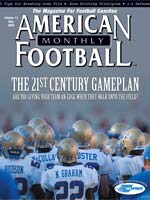Article CategoriesAFM Magazine
|
Unsung HeroSubtitle A week in the life of Tulsa’s video coordinator, Gabe Haneyby: Keith Roerdink © More from this issue A week in the life of Tulsa’s video coordinator, Gabe Haney Good coordinators are vital to the success of any college football program. But if all you’re thinking about is the guys in charge of your offense and defense, then you’ve overlooked a key position. When time is tight and the stakes are high, you better make sure that you’ve got a top-flight video coordinator who can break down every bit of information about your opponent and your own team into bite size nuggets for your staff and players to digest.
|
|
|||||||
| HOME |
MAGAZINE |
SUBSCRIBE | ONLINE COLUMNISTS | COACHING VIDEOS |
Copyright 2025, AmericanFootballMonthly.com
All Rights Reserved





